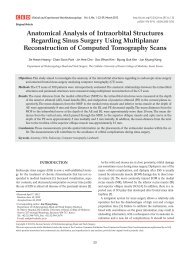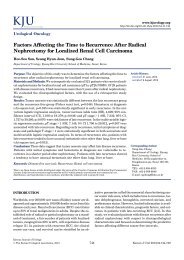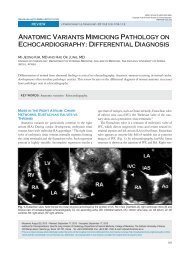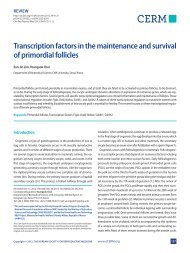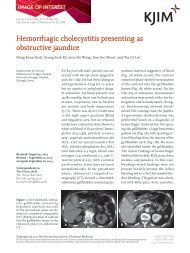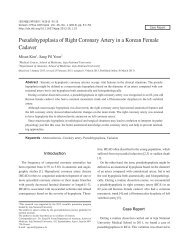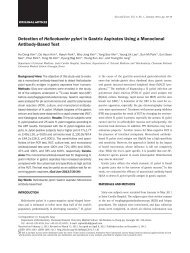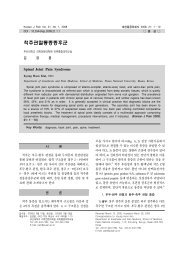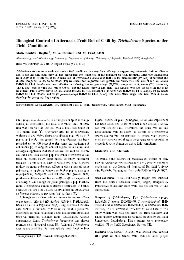Diprosopus, craniorachischisis, arthrogryposis, and other associated ...
Diprosopus, craniorachischisis, arthrogryposis, and other associated ...
Diprosopus, craniorachischisis, arthrogryposis, and other associated ...
Create successful ePaper yourself
Turn your PDF publications into a flip-book with our unique Google optimized e-Paper software.
J. Vet. Sci. (2008), 9(4), 429
430 Cihan Kaçar et al.<br />
Fig. 1. (A) Frontal view of the diprosopic lamb. (B) Craniorachischisis.<br />
A tapering membranous structure covering the spinal<br />
cord (arrows). (C) Agnathia in the left head. Skin covering the<br />
presumptive location of the lower jaw (arrow). (D) A rudimentary<br />
tongue, which is adherent to the palate, in the left head<br />
(arrow). (E) Dorsal view of the lamb’s vertebral column. Severe<br />
deformation in the vertebral column. Scoliosis in the thoracal<br />
vertebrae (arrow). (F) Lateral radiograph of the lamb. Kyphosis<br />
in the cervical, thoracal, <strong>and</strong> lumbar vertebrae (arrows). (G)<br />
Microscopic view of disorganization in the left brain. Fibrous tissue<br />
in the brain (arrow). Masson’s trichrome. Scale bar = 56 μm.<br />
(H) Intervention of the neural (N) <strong>and</strong> dermal (D) tissues under<br />
the membranous structure. Masson’s trichrome. Scale bar = 140<br />
μm.<br />
sphenoides. The whole parietal bones <strong>and</strong> squama<br />
occipitalis of the occipital bones <strong>and</strong> foramen magnum<br />
were absent, <strong>and</strong> hence both brains were exposed caudally.<br />
All vertebrae from the cervical to the sacral spine were<br />
deformed. The discus intervertebrae were absent. The<br />
joining of the corpus vertebrae was chondroitic. Arcus<br />
vertebrae were absent to the tail, <strong>and</strong> hence the vertebral<br />
canal was not observed, except in the caudal region. The<br />
processus transversales were absent. Since the cervical<br />
vertebrae were severely deformed, the atlas <strong>and</strong> axis could<br />
not be distinguished. Therefore, the typical atlanto-occipital<br />
<strong>and</strong> atlanto-axial joints were undetermined. There were<br />
five rib-like bones in each side located on the dorso-lateralis<br />
of the thoracal vertebrae. The vertebral canal was present at<br />
the caudal level. Scoliosis was present in the thoracal<br />
vertebrae (Fig. 1E). There was kyphosis at the cervical,<br />
thoracal, <strong>and</strong> lumbar levels (Fig. 1F). The ossa coxae were<br />
close to each <strong>other</strong>, <strong>and</strong> the pelvic cavity was narrowed.<br />
The right brain weighed 28.1 g. A pair of olfactory, optic,<br />
<strong>and</strong> oculomotor nerves, a sella turcica, <strong>and</strong> a hypophysis<br />
were present. The right brain bowed slightly to the median<br />
in accordance with the shape of the cranium. The left brain<br />
weighed 2.4 g. Olfactory, optic, <strong>and</strong> oculomotor nerves<br />
were present in the left brain. However, the sella turcica<br />
<strong>and</strong> hypophysis were absent. A hypoplastic medulla<br />
oblongata was present, <strong>and</strong> the cerebella were absent in<br />
both heads.<br />
Arthrogryposis flexio was observed in both articulationes<br />
metacarpophalangeae <strong>and</strong> the right articulationes<br />
metatarsophalangeae. There was a hemorrhagic substance<br />
in the thoracal cavity. Petechiae were also present on the<br />
surfaces of the lungs <strong>and</strong> heart.<br />
Microscopically, disorganized cerebral structures, degeneration<br />
<strong>and</strong> necrosis of neurons, hyperemia, <strong>and</strong> extravasal<br />
erythrocytes were observed in both brains. Disorganization<br />
was more severe in the smaller brain (Fig. 1G). On<br />
microscopic sections taken from the membranous structure,<br />
a tapering narrow b<strong>and</strong> of epidermis was noted; right under<br />
it was a dermis composed of fibroblasts, fibrocytes,<br />
collagen, <strong>and</strong> lymphocytes. No hair follicles or sweat or<br />
sebaceous gl<strong>and</strong>s were noted at this location. Where the<br />
epidermis ended in this membranous structure, only<br />
dermis was visible. Dermal <strong>and</strong> neural tissues were<br />
intervening, <strong>and</strong> in some places, neural tissue isl<strong>and</strong>s were<br />
observed in this membranous structure (Fig. 1H).<br />
Congenital duplications have been a matter of interest for<br />
centuries. An incomplete division of the zygote at a<br />
considerably late stage of embryonic development is<br />
considered to be the reason for congenital duplication [14].<br />
These malformations can appear as a graded series from a<br />
slight duplication to almost complete separation of the<br />
twins, <strong>and</strong> hence can be classified as attached, free<br />
symmetrical <strong>and</strong> attached, or free asymmetrical twins<br />
[7,14]. Cranial duplications can be either diprosopus or<br />
dicephalus [7,16]. While diprosopus is characterized by<br />
fusion of the craniofacial structures of the two heads<br />
[5,11,13,15], partial duplication of the spine with the<br />
presence of two heads is described as dicephalus [8,10,12].<br />
We regarded this case as diprosopus because of the fusion<br />
of the two heads at the occipital level. In most reported<br />
diprosopic animals, the two heads <strong>and</strong> the features of them<br />
have more or less resembled each <strong>other</strong> [11,13,15,17,18].<br />
However, the two heads in this lamb were very different,<br />
not only in size, but also in anatomic structure.<br />
Cleft palate is one of the most common anomalies, <strong>and</strong> it<br />
is commonly <strong>associated</strong> with diprosopus [4,9,19]. We also<br />
observed cleft palate in the right head of this diprosopic
lamb. Among the <strong>other</strong> defects, agnathia in the left head<br />
<strong>and</strong> brachygnathia superior in the right head are<br />
noteworthy in estimating the developmental difference of<br />
the two heads.<br />
In the present study, the weights of the right <strong>and</strong> left brains<br />
were recorded as 28.1 g <strong>and</strong> 2.4 g, respectively, which were<br />
below the normal range of 58-70 g [6]. Therefore, both brains<br />
were described as micrencephalic. It has been reported that<br />
there is generally a fused cerebellum [4,15,17-19] or two<br />
cerebella [5,11] present in diprosopus. However, cerebellar<br />
agenesis was observed in the present diprosopic lamb.<br />
Spina bifida is a broad term used to describe neural tube<br />
defects characterized by a failure in closure of the vertebral<br />
arches. The most severe form of this malformation is called<br />
rachischisis, which is characterized by an open spine [14].<br />
If rachischisis combines with a closure defect of the<br />
cranium, it is called <strong>craniorachischisis</strong> [1]. We have also<br />
described a case of diprosopus with <strong>craniorachischisis</strong> in a<br />
lamb.<br />
The etiology of most congenital malformations is unknown,<br />
simply because of the complexity of the mechanisms<br />
leading to the formation of an abnormality. Genetic <strong>and</strong><br />
environmental factors, or their interaction, have been<br />
proposed as the most common causes of congenital<br />
abnormalities [3]. Whatever the cause of the congenital<br />
defects, the countless varieties of a certain anomaly from<br />
animal to animal might be explained by the degree <strong>and</strong><br />
time course of the effects of several etiologic factors of<br />
presumed lesser importance. In the current investigation,<br />
since we were unable to obtain the pedigree <strong>and</strong> history of<br />
the m<strong>other</strong>, no etiologic cause or causes could be<br />
ascertained.<br />
In this study, we described the gross <strong>and</strong> histopathologic<br />
findings in a diprosopic conjoined twin lamb with<br />
<strong>craniorachischisis</strong> <strong>and</strong> <strong>arthrogryposis</strong>. The importance of<br />
these malformations, in general, lies in the embryologic<br />
development of the fetus <strong>and</strong> the particular mechanisms that<br />
relate to such significant changes during organogenesis.<br />
The precise etiology of these malformations is still largely<br />
unknown <strong>and</strong> requires further investigation.<br />
References<br />
1. C<strong>and</strong>a MŞ, C<strong>and</strong>a T. Temel patoloji 4: Nöropatoloji. pp.<br />
<strong>Diprosopus</strong>, <strong>craniorachischisis</strong>, <strong>arthrogryposis</strong>, <strong>and</strong> <strong>other</strong> <strong>associated</strong> anomalies in a stillborn lamb 431<br />
13-20, Ege Üniversitesi Yayını, Bornova, 1992.<br />
2. Dennis SM. Perinatal lamb mortality in western Australia. 7.<br />
Congenital defects. Aust Vet J 1975, 51, 80-82<br />
3. Dennis SM, Leipold HW. Ovine congenital defects. Vet<br />
Bull 1979, 49, 233-239.<br />
4. Dozsa L. A case of rare monstrosity in a calf. Pathol Vet<br />
1966, 3, 226-233.<br />
5. Fisher KRS, Partlow GD, Walker AF. Clinical <strong>and</strong> anatomical<br />
observations of a two-headed lamb. Anat Rec 1986,<br />
214, 432-440.<br />
6. Hartley WJ, Haughley KG. An outbreak of micrencephaly<br />
in lambs in New South Wales. Aust Vet J 1974, 50, 55-58.<br />
7. Hiraga T, Dennis SM. Congenital duplication. In: Dennis<br />
SM (ed.). The Veterinary Clinics of North America, Food<br />
Animal Practice. Congenital Abnormalities. pp. 145-161,<br />
Saunders, Philadelphia, 1993.<br />
8. Leipold HW, Dennis SM. Dicephalus in two calves. Am J<br />
Vet Res 1972, 33, 421-423.<br />
9. Leipold HW, Dennis SM. <strong>Diprosopus</strong> in newborn calves.<br />
Cornell Vet 1972, 62, 282-288.<br />
10. Madarame H, Ito N, Takai S. Dicephalus, Arnold-chiari<br />
malformation <strong>and</strong> spina bifida in a Japanese black calf. J Vet<br />
Med A 1993, 40, 155-160.<br />
11. Mazzulo G, Germanà A, De Vico G, Germanà G.<br />
Diprosopiasis in a lamb. A case report. Anat Histol Embryol<br />
2003, 32, 60-62.<br />
12. McGirr WJ, Partlow GD, Fisher KRS. Two-headed,<br />
two-necked conjoined twin calf with partial duplication of<br />
thoracoabdominal structures: Role of blastocyst hatching.<br />
Anat Rec 1987, 217, 196-202.<br />
13. Moerman P, Fryns JP, Goddeeris P, Lauweryns JM, Van<br />
Assche A. Aberrant twinning (<strong>Diprosopus</strong>) <strong>associated</strong> with<br />
anencephaly. Clin Genet 1983, 24, 252-256.<br />
14. Noden DM, De Lahunta A. The Embryology of Domestic<br />
Animals: Developmental Mechanisms <strong>and</strong> Malformations.<br />
pp.109-152, Williams &Wilkins, Baltimore, 1985.<br />
15. Ozcan K, Ozturkler Y, Sozmen M, Takci I. <strong>Diprosopus</strong> in<br />
a cross bred calf. Indian Vet J 2005, 82, 650-651.<br />
16. Roberts SJ. Veterinary Obstetrics <strong>and</strong> Genital Disease<br />
(Theriogenelogy). 3th ed. pp. 51-91, Edwards Br<strong>other</strong>s,<br />
Woodstock, 1986.<br />
17. Saperstein G. <strong>Diprosopus</strong> in a hereford calf. Vet Rec 1981,<br />
108, 234-235.<br />
18. Sönmez G, Özbilgin S, Serbest A, Mısırlıoğlu, D. A case<br />
of diprosopus in a kid. Uludağ Üniv Vet Fak Derg 1992, 11,<br />
93-98.<br />
19. Türkütanıt SS, Sağlam YS, Bozoğlu H. <strong>Diprosopus</strong> in a<br />
calf. İstanbul Üniv Vet Fak Derg 1996, 22, 253-256.



